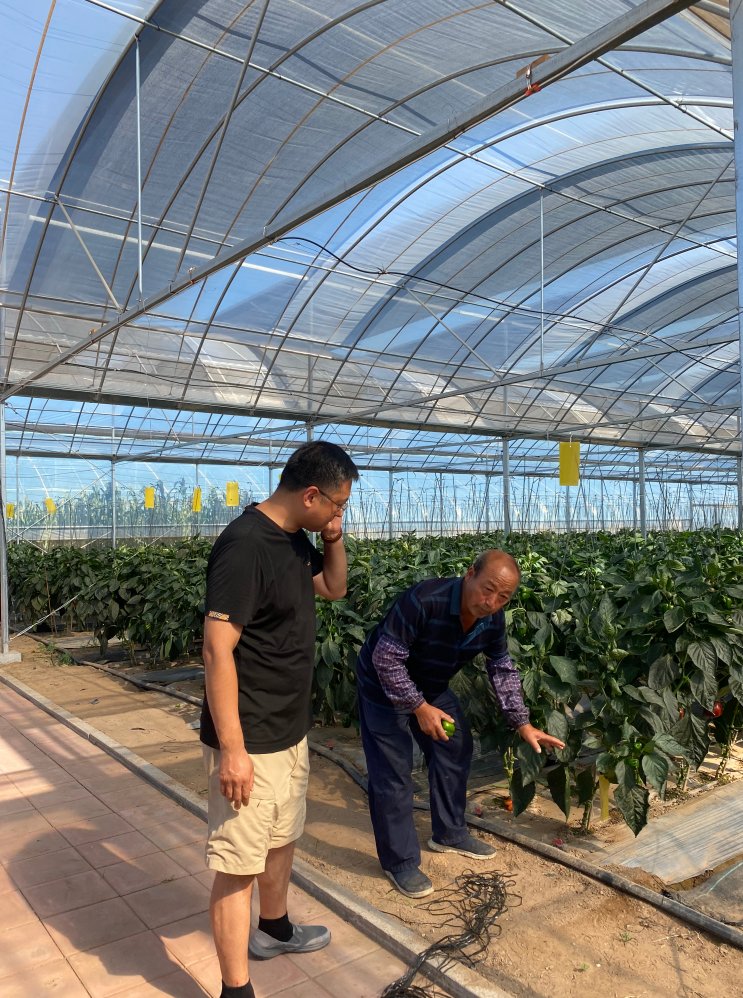On-site guidance on the use of pesticides in pepper bases
In August 2023, we went to a farm that specializes in growing peppers to give on-the-spot pesticide use suggestions, solving an urgent need for the farmers.


Frequently Asked Questions about Pepper Planting:
1. Mosaic disease
Viral diseases caused by cucumber mosaic virus, tobacco mosaic virus, cowpea mosaic virus, etc. The upper leaves of the diseased plant first appear with alternating
dark green and light green mosaics and leaves, severe shrinkage and deformed yellow flowers, the diseased plant has weak growth, short internodes, and sparse
flowering abnormalities. Use dimethoate, alkaloids, fenvalerostrobin, imidacloprid, etc. to kill insects, and sterol, dextranose, guanidine·zinc sulfate, sophora
flavescens·sulfur (virus killer) to kill viruses.
2. Viral diseases
Viral diseases caused by tobacco mosaic virus, cucumber mosaic virus, etc. The mosaic-type diseased parts have irregular greening, and the diseased fruits are deformed
and small. In the etiolated type, diseased leaves turn yellow (the upper part is completely yellow), become dwarfed and fall off. Necrosis type mottled, striped disease death,
top withered, etc. The deformed diseased leaves are thickened, smaller, shrunken, and bent, the internodes are shortened and dwarfed, the branches and leaves are filamentous
and clustered, and the diseased fruits are deformed, uneven, and easy to fall off.
Use chlorobromoisocyanuric acid, alkanol·copper sulfate, alkenol·copper sulfate, mixed fat·copper sulfate, moguanidine·copper acetate, aminooligosaccharides, lentinan,
ningnanmycin, octoprovinyl acetate Salt etc spray. Dinucleoside triazole, tridecylguanidine, copper pinoresinate, alkaloid fungicides and brassinoids.
3. Bacteria wilt
Bacterial disease caused by Raulella solanacearum. The fine roots of the diseased plant turn brown and then rot and disappear. When the diseased stem is cut across the ground,
the vascular bundles are slightly browned and secrete milky white bacterial fluid. In the later stage, the diseased plant quickly wilts and dies, but the stems and leaves remain green.
When planting, soak the roots with agricultural streptomycin sulfate and methamphetamine, and irrigate the roots with fungicides (Keshid, Zhongshengmycin, and Copper Ammonia).
Inject non-pathogenic Ralstonia solanacearum to occupy the ecological niche before disease-free. Use new phytomycin, streptomycin sulfate, Solanacetin (Zhongsheng thiocumazole),
Dofuzin, Qixiaofugenkang, and sprinkler irrigation.
4. Soft rot
Bacterial diseases caused by E. carotovora and Rhizopus fungi. The main damage to the fruit is that water-soaked dark green spots appear in the early stage, and then turn brown and
yellow to rot. They are easy to fall off when exposed to external force. When broken, ulcers will flow out. If they do not fall off, they will hang dry and leave white skin. To control cotton
bollworm, use Duofu·Fuzinc, Duofu·Thiazolin, Duofuxin·Bacillin and Genkang sprinkler irrigation.
5. Black spot
Diseases caused by fungi such as Bivalvia rosea and Pseudomonas aeruginosa and bacteria of the genus Pseudomonas. The main damage is to fruits, with irregular light brown sunken
lesions appearing first (one spot per fruit), and then becoming large lesions. Use chlorothalonil, antiseptic alum, metalaxyl and manganese zinc spray.
6. Capsicum scab
Also known as bacterial spot, it is a disease caused by the pathogen Xanthomonas capsicum spot in wild rapeseed. It mainly damages the leaves. Many small lesions appear on the diseased
leaves. The back side of the leaves is raised and the front side is sunken, causing large areas of defoliation and fruit rot. When transplanting, spray the new high-fat film to shorten the seedling
slowing period and strengthen the pepper seedlings. Kasugamycin, Aimiao EC, Zhuangmiaoling. Phytazole, difenoconazole, agricultural streptomycin, and copper amine aqueous spray.
Mancozeb, chlorothalonil, sulfur, zhongshengmycin, copper hydroxide, ningnanmycin, hydramycin.

